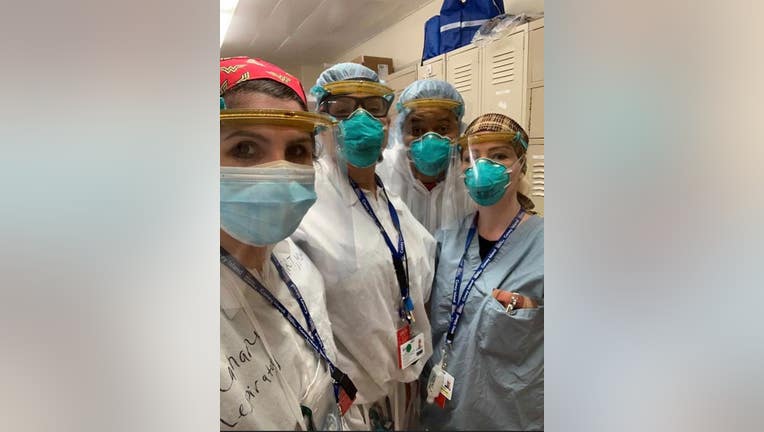Valley respiratory therapist describes conditions in New York City during COVID-19 pandemic

(Photo Courtesy: Shana Simon)
PHOENIX - A Valley respiratory therapist has returned from the epicenter of the COVID-19 pandemic.
Shana Simon lives in San Tan Valley, and was deployed to Brooklyn in New York City in early April. What she says she witnessed has changed her life, and not just as a healthcare worker
"It was chaos," said Simon.
Simon said she has never seen anything like what the COVID-19 pandemic did to a hospital on Coney Island.
"I’ve seen more people die in the last six weeks than I have in the entire almost six years I’ve been a therapist," said Simon.
As a respiratory therapist, Simon manages ventilators and treats patients on life support. For six weeks, Simon worked non-stop, as she says the ER overwhelmed a thin staff.
"80% of their staff was gone because they all caught COVID, so there are two [respiratory therapists] for this whole hospital that has, like, over 150 ventilators running," said Simon.
Simon says a majority of incoming patients with coronavirus had underlying health conditions, like diabetes and hypertension.
"They could barely breathe. They could barely talk to you. They're scared. They’re trying to hold your hand. They’re telling us 'Hey. Please don’t let me die,'" Simon recounted.
As Arizona slowly reopens, Simon tries to stay positive, but says it's clear many won't follow social distancing guidelines or wear masks in public.
"Like, very flippant of the situation. Like it’s not as serious as it is. I think it could possibly happen, but I think one of the benefits we have in Phoenix is the fact that we’re not so densely populated," said Simon.
As of Thursday, Simon has been back for about five days. She is in self-quarantine at a hotel, and will be able to see her kids in a little more than a week.
LIVE: Interactive Coronavirus case data and map
FULL COVERAGE: fox10phoenix.com/coronavirus
FOX 10 is working to keep you up to date with local and national developments on COVID-19. Every weekday on FOX News Now, our live coverage begins at 7 a.m. MST reporting the latest news, prevention tips and treatment information.
You can watch live in your FOX 10 News app or on the FOX 10 Facebook page.
Get the latest coronavirus news by downloading the FOX 10 News App. Our promise is that our alerts are there to inform you - not scare you.
You can also get the latest coronavirus news from around the country at coronavirusnow.com.
COVID-19 symptoms
Symptoms for coronavirus COVID-19 include fever, coughing, and shortness of breath. These, of course, are similar to the common cold and flu.
Expect a common cold to start out with a sore or scratchy throat, cough, runny and/or stuffy nose. Flu symptoms are more intense and usually come on suddenly, and can include a high fever.
Symptoms of COVID-19 may appear more slowly. They usually include fever, a dry cough and noticeable shortness of breath, according to the World Health Organization. A minority of cases develop pneumonia, and the disease is especially worrisome for the elderly and those with other medical problems such as high blood pressure, obesity, diabetes or heart conditions.
RELATED: Is it the flu, a cold or COVID-19? Different viruses present similar symptoms
Right now there's one big difference between flu and coronavirus: A vaccine exists to help prevent the flu and it's not too late to get it. It won't protect you from catching the coronavirus, but may put you in a better position to fight it.
To protect yourself, wash your hands well and often, keep them away from your face, and avoid crowds and standing close to people.
And if you do find yourself showing any of these flu or coronavirus symptoms - don't go straight to your doctor's office. That just risks making more people sick, officials urge. Call ahead, and ask if you need to be seen and where.
In order to protect yourself from a possible infection, the CDC recommends:
Avoid close contact with people who are sick.
Avoid touching your eyes, nose, and mouth.
Stay home when you are sick.
Cover your cough or sneeze with a tissue, then throw the tissue in the trash.
Clean and disinfect frequently touched objects and surfaces using a regular household cleaning spray or wipe.
Wash your hands often with soap and water for at least 20 seconds, especially after going to the bathroom; before eating; and after blowing your nose, coughing, or sneezing.
Additional resources
Coronavirus (COVID-19) - How it spreads, symptoms, prevention, treatment, FAQ
https://www.cdc.gov/coronavirus
https://espanol.cdc.gov/enes/coronavirus/2019-ncov/index.html (In Spanish/En Español)
Arizona COVID-19 Response - Public resources, FAQ, webinars
https://www.azdhs.gov/coronavirus
https://www.azdhs.gov/preparedness/epidemiology-disease-control/infectious-disease-epidemiology/es/covid-19/index.php#novel-coronavirus-home (In Spanish/En Español)
Related Stories
Coronavirus: What to do if you’re told to self-quarantine
Does wearing a face mask protect you from coronavirus and other infectious diseases?
Social distancing: What to do and what not to do to slow the spread of COVID-19

